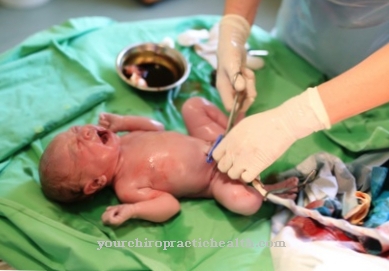The Magnetic resonance angiography serves as a diagnostic method for the graphic representation of blood vessels. In contrast to conventional examination methods, the use of X-rays is not necessary. However, there are also contraindications to using this procedure.
What is magnetic resonance angiography?

Magnetic resonance angiography, too MRA called, is an imaging procedure that is used to diagnose blood vessels. It is based on magnetic resonance imaging.
The main objects of investigation are the arteries. In rarer cases, veins are also examined. In some cases, completely non-invasive techniques can be used here that do not require surgical interventions or injections. In contrast to conventional angiography, no catheter has to be inserted. There are also methods of magnetic resonance angiography that are performed with contrast media.
However, the use of harmful X-rays is not applicable. Instead of the two-dimensional images that are generated in conventional angiography, magnetic resonance angiography generally records three-dimensional data sets. This enables the vessels to be assessed from all directions. Magnetic resonance angiography is used for suspected arteriosclerosis, embolisms, thromboses, aneurysms or other vascular malformations.
Function, effect & goals
Magnetic resonance angiography, like general magnetic resonance tomography, is based on the physical principles of nuclear magnetic resonance. It is based on the fact that the atomic nuclei, in this case the protons (hydrogen atom nuclei), have a spin in the chemical compounds.
Spin is defined as torque. The torque creates a magnetic moment as a moving charge. When an external stationary magnetic field is applied, the magnetic moment of the proton aligns with this field. A weak longitudinal magnetization (paramagnetism) is generated. If a strong alternating field is applied transversely to the direction of the static magnetic field, the magnetization tilts and is partially or completely converted into a transverse magnetization.
A precession movement of the transverse magnetization around the field lines of the static magnetic field begins immediately. A coil registers this precession movement by changing the electrical voltage. When the alternating field is switched off, the magnetic moments of the protons align themselves again with the static magnetic field. The transverse magnetization slowly decays. This decay time is called relaxation. However, the relaxation depends on the physical and chemical environment of the protons.
The transversal magnetizations in the various tissues and areas of the body need different times to decay. These different relaxations are expressed in the image by differences in brightness. Only then does the three-dimensional image arise. This principle also applies to the representation of blood vessels, which is then referred to as magnetic resonance angiography. There are many different techniques for magnetic resonance angiography. Three methods are used particularly frequently.
These methods include time-of-flight MRA, phase-contrast MRA and contrast-enhanced MRA. The time-of-flight MRA (TOF-MRA) is based on the different magnetization of freshly flowing blood and the surrounding tissue. This makes use of the fact that the inflowing blood is more strongly magnetized than the stationary tissue. The magnetization of the tissue in question has already been reduced by the action of a high frequency field.
The different signal intensities of the blood and the tissue are shown as an image. When displaying images, however, artifacts often occur if the blood has flowed in the examination area for a long time. In order to reduce the exposure time of the HF field to the blood, the examination field should be perpendicular to the direction of blood flow with this method. No contrast agent is required for the time-of-flight MRA because fast 2D or 3D gradient techniques can be used here.
Phase contrast MRA plays an important role as a further method. Similar to the time-of-flight MRA, the differences between flowing blood and surrounding tissue are also shown here with a high level of signals. Here, however, the blood is not distinguished by the magnetization, but by the phase differences to the tissue. No contrast agent is required with this method either. The third method is known as contrast-enhanced MRA. It is based on the injection of a contrast medium, which significantly shortens the relaxation. Compared to the other two methods, the image acquisition time is greatly reduced in contrast-enhanced magnetic resonance angiography.
Risks, side effects & dangers
Compared to conventional angiography, magnetic resonance angiography has many advantages but also disadvantages. The application of this method does not require any surgical intervention. A catheter does not have to be placed.
However, it may have a disadvantage here that examination and simultaneous treatment cannot be combined. As part of magnetic resonance angiography, three-dimensional images are created that allow the vessels to be assessed from different viewing directions. But there are also clear contraindications to the use of this method. These contraindications mainly relate to the effects of the magnetic field.
For example, people with pacemakers or defibrillators are not allowed to undergo magnetic resonance angiography. The magnetic field used can damage the devices and cause health problems. Even if there are iron fragments or other metallic objects (e.g. Cavafilter) in the body, the use of this method is contraindicated. Magnetic resonance angiography should also not be used in the first 13 weeks of pregnancy.
There is also a contraindication when wearing a cochlear implant (hearing prosthesis). This device contains a magnet. With some cochlear implants, however, an MRA can be performed after the manufacturer has given precise instructions. Implanted insulin pumps do not allow magnetic resonance angiography, as these devices can also be damaged. In the case of tattoos with color pigments containing metal, the MRA can burn the skin. Magnetic resonance angiography is also not recommended for non-removable magnetic piercings in the examination area.













.jpg)

.jpg)
.jpg)











.jpg)